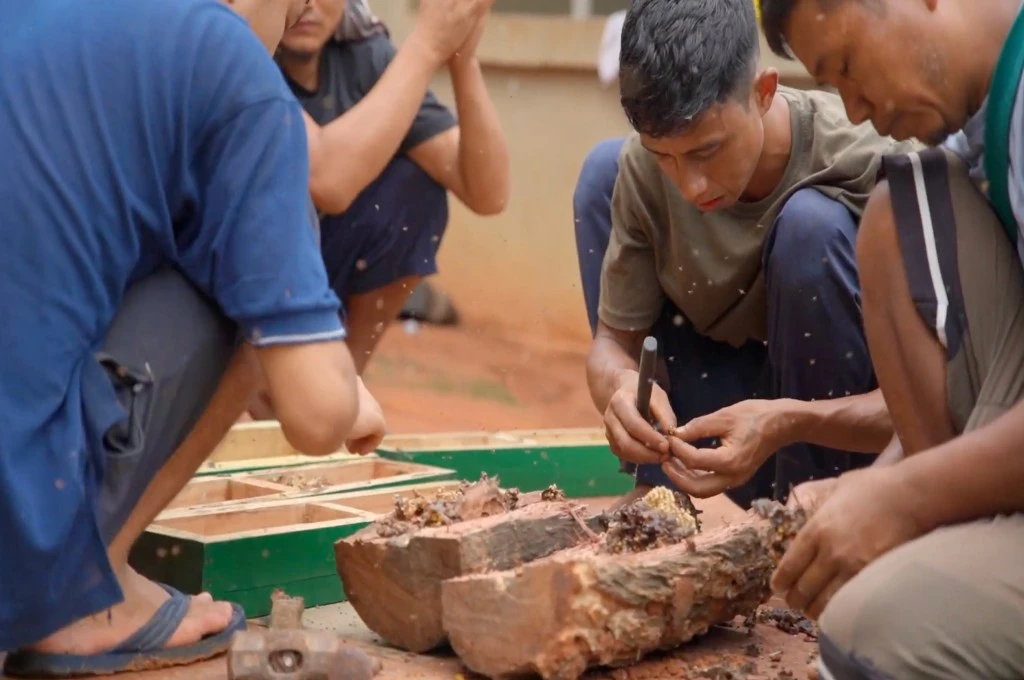In Nagaland, dried flowers are a common sight in markets and stores. Many locals believe that the practice started in the 1990s in a bid to prevent fresh flowers from decaying and to prepare for the seasons during which certain flower varieties do not bloom. While Nagaland’s geography and climate supports many seasonal flowers, they are not available throughout the year, and this prompted the development of preservation techniques to extend their aesthetic value.
Zuchano Kithan, a flower aficionado who currently works at a financial institution, says, “Growing up in Wokha [a town near Kohima] in the 1990s, my sisters and I cultivated seasonal flowers, especially ornithogalum [grass lily]. We would plant them in our houses. Once the season got over, we would notice that potted flowers would dry up, their white hues transformed into an elegant off-white shade. We started hanging the flowers upside down to preserve their beauty. My father is also quite fond of wildflowers and during his outings in the forest, he would bring them home and dry them.”
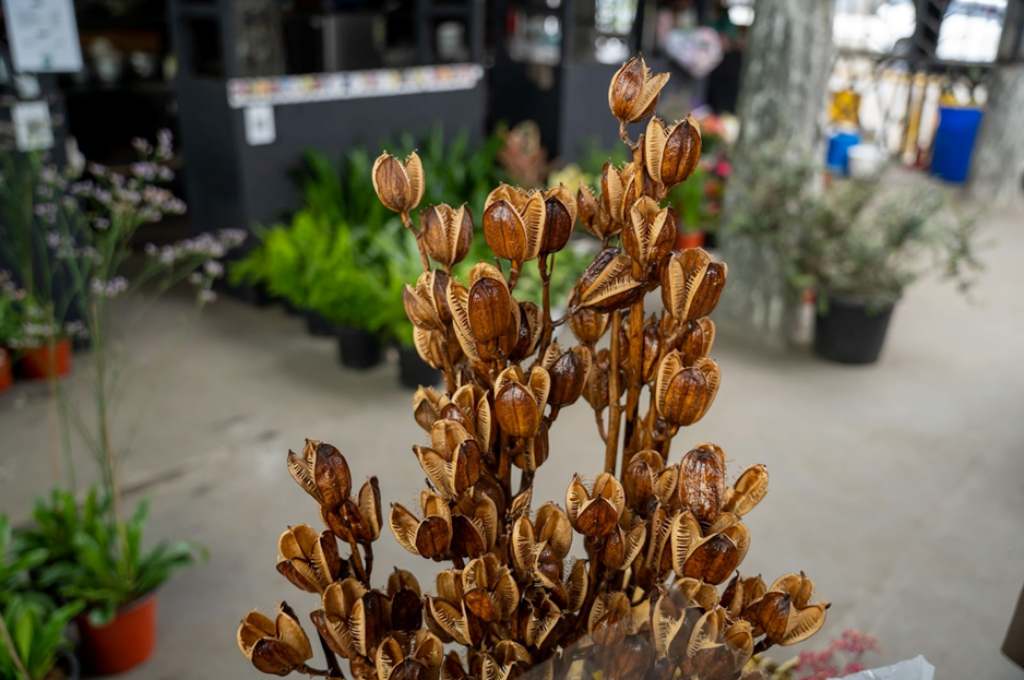
However, the flower drying tradition that began as a necessity has become a livelihood option for many women. These women sell bouquets, bookmarks, and all kinds of flower decorations at shops, pavements, and markets. This photo essay documents the florists’ experiences, their journeys of entrepreneurship, challenges, and opportunities. It also offers a glimpse into the gradual changes that the popularity of dry flowers has brought to Nagaland’s society.
Why dry the flowers?
In recent years, there’s been a notable shift in consumer behaviour in Nagaland. Multiple local florists have reported that people now place a higher value on flowers, which has led to an increase in flower purchases and their use as a popular gifting option. Different flowers and their colours symbolise various sentiments, such as friendship, love, peace, and gratitude; sometimes, flowers simply represent the joy of giving. While many adore fresh flowers, they have a fleeting lifespan. Ceremonies and parties often feature fresh floral decorations that are discarded afterwards. In recent years, dry flowers have emerged as a symbol of eco-friendly living, offering an attractive option to those seeking to make a difference with their gift choices.
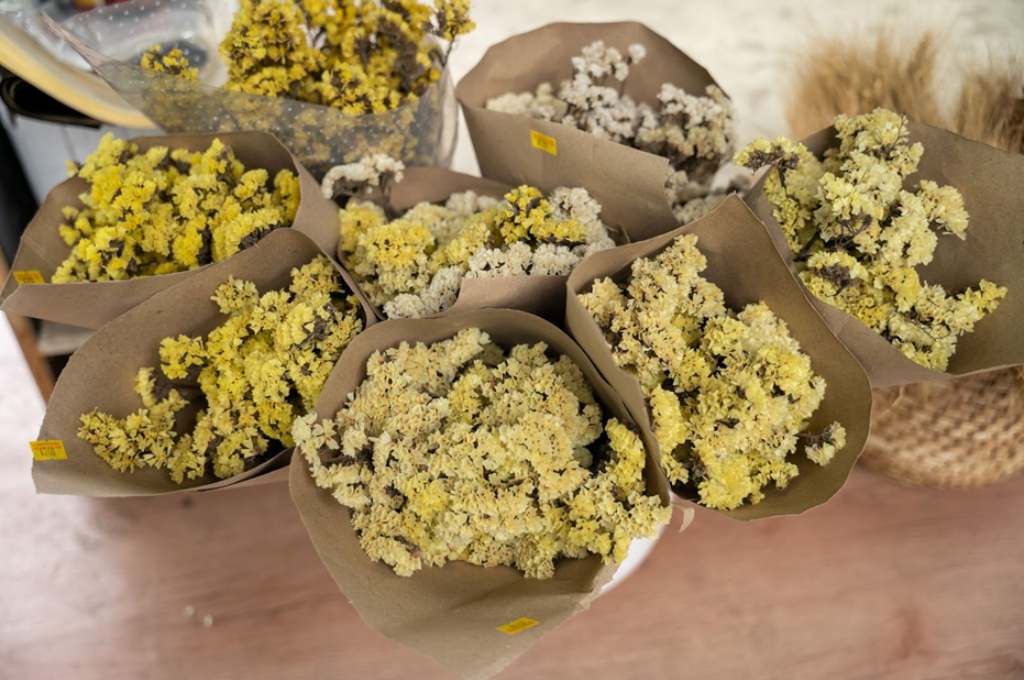
According to Zuchano, dried flowers, with their extended lifespan, have become an ideal gifting choice. Many people also opt to dry the fresh flowers they receive to preserve the memory of the gift and cherish it for a longer period.
There are additional reasons behind the popularity of dry flowers in the state. Local florists opine that majority of the fresh flowers sold in Nagaland are sourced from outside the state, whereas all the dry flowers are locally produced. Vendors rely on external sources because only seasonal flowers—such as orchids, statice, and lilies—thrive in Nagaland; even though they bloom in certain areas, perennial flowers such as cosmos and chrysanthemum are unsuitable for the general climate. When the flowering season ends, some unsold flowers are dried and prepared for sale.

Flower preservation is a delicate and lengthy process that varies depending on seasonal patterns, market demands, and other factors. One such popular dried flower impacted by these is statice, commonly found in markets and flower shops. In the hilly regions, it is grown during the spring season (March-April), whereas in the plains, it is planted in October and November. After the harvest, florists dry these flowers by hanging them upside down to prevent drooping and preserve their beauty.
While some flowers are naturally dried, others are painted to enhance their vibrancy and meet market demands. In Kohima, florists often paint their dry flowers to protect them from mould, especially during the intense rainy season.
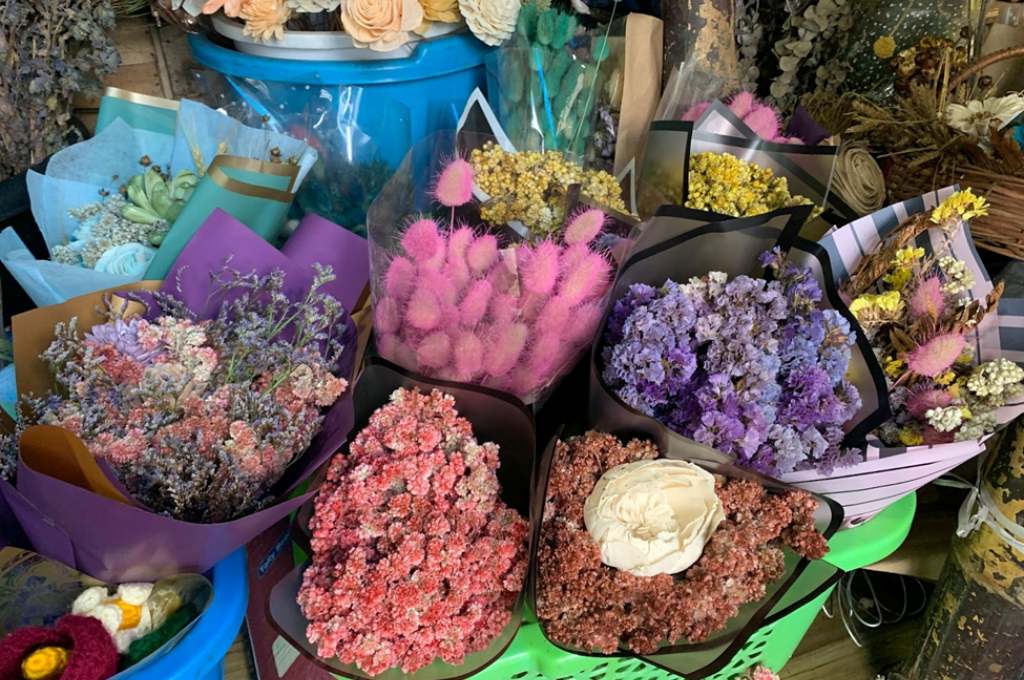
A blooming business for women entrepreneurs
The flower business in Nagaland has provided many women with a stable livelihood. Dzuvinu Tetso is one such woman. Dzuvinu runs a successful stall in the Bamboo Market at BOC, a neighbourhood in Kohima. After selling vegetables for a few years, she transitioned fully into the flower business in 2021. She is well known for her dry flowers, which she hangs above her shed to dry. “I also sell fresh flowers, but they often bring losses if left unsold because they rot quickly. With dry flowers, there is no loss as they can be kept year-round. It is also the dry flowers that attract tourists and customers to my store,” she says. Through her business, Dzuvinu is able to support her family. However, she hopes for a larger space as her current stall is congested, making it difficult for customers to move around and for her flowers to be displayed properly.
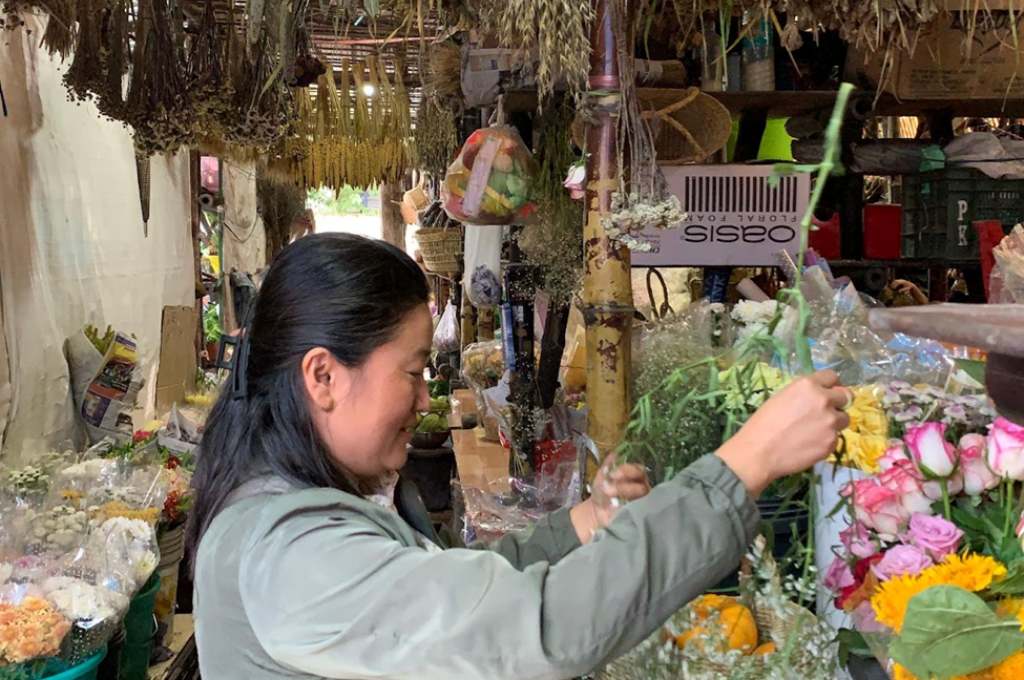
Like Dzuvinu, Temsuyangla Pongen too has been a florist for many years, supporting her family through her business, which focuses mainly on indoor plants—a high-demand market. Temsuyangla, who is also the vice president at Nagaland Flower Growers Society (a nonprofit that supports the entrepreneurs), explains, “Indoor plants and dry flowers have a longer lifespan if cared for properly. Their longevity also makes them very profitable. I made a bouquet out of dry flowers for a politician five years ago, and it still looks just as new today.”
The prospect of being an entrepreneur and the freedom that it brings is pushing many people to choose the flower business over jobs that are traditionally considered aspirational. Rukunu Kennao, owns a flower shop at the Kohima Trade Centre, where she sells both dry and fresh flowers. Before starting her business in November 2023, she practised as a private advocate at Kohima District Court for four years. Many florists in Nagaland have gone digital and use Instagram to showcase and sell their products; often, they also receive orders from outside the state. Rukunu too runs an Instagram account (peta_lparadise) where she showcases and sells flowers, though she finds it challenging to post daily due to her full-time commitment to the store. Her passion for fresh flowers has also inspired her to start growing them locally, but she is currently unable to construct a polyhouse—a polyethylene or glass structure that allows plants to grow in a controlled climate—due to its high cost.
The first-mover’s disadvantage
The dry flower business has come a long way since the early 1990s, when entrepreneurs struggled for exposure and access to larger markets. For example, Kevimese-ii, who began preserving flowers in 1994 in her early 20s, recounts, “In the past, dried flowers would normally appear in markets during the winter season, but now they are available throughout the year.” For her, it was more of a hobby. She used the flowers to make bookmarks and framed decorations that she gifted to her friends and displayed as personal home decor.
Kevimese-ii once dreamed of turning her vocation into an entrepreneurial venture but without success. She explains, “Around 1994–95, I was introduced to a businessman who mentioned that he would be participating in an exhibition at Dilli Haat [an open-air craft bazaar in Delhi with stalls from several Indian states]. I prepared several framed dried flowers pieces and sent them for the event, hoping to earn some money and kickstart my venture. But once he left, I never received any communication or updates from him.”
However, the current landscape is different: there are no middlemen and nowadays, many flower entrepreneurs have embraced mobile phones and social media. Kevimese-ii credits the success of this new generation of flower sellers to their entrepreneurial spirit and creativity, support from the government and locals, as well as the extensive reach of the internet.
Flower together
The change can also be attributed to the various attempts at collectivising the florists in the state. The Nagaland Flower Growers Society, founded in 2006, provides a platform for flower growers to support each other and expand their market presence. Meyievino, the society’s general secretary, explains that the platform was initiated by the Nagaland government’s horticulture department when they started working on floriculture. Although the initiative began with the aid of the state government, the society now operates as a registered non-governmental organisation. On the second Friday of each month, the society organises a sale at the farmers’ market in PWD Colony, Kohima. Groups of home-based and aspiring florists are given the space to sell their products on a rotational basis, as the market cannot accommodate all members at once.
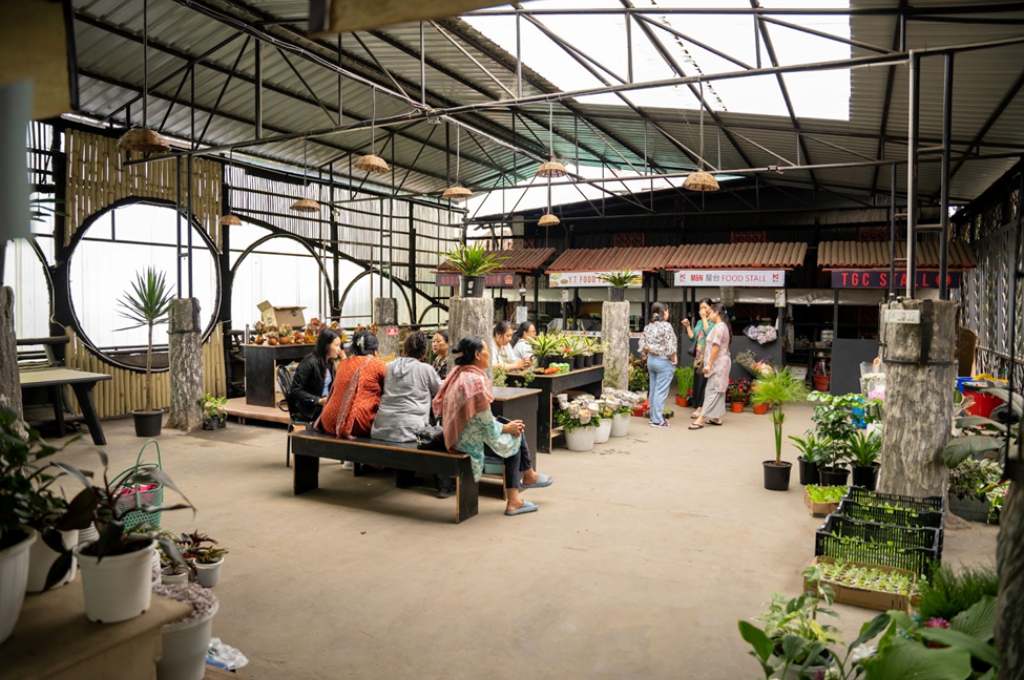
When asked about the supply of fresh flowers from outside the state, Meyievino says, “We encourage our members to grow fresh flowers, but starting such an operation requires significant capital, which many of our members lack. It’s also challenging to secure investments for a flower business. Last year, some of us took out a small loan to construct a low-cost polyhouse, but unfortunately, this year’s winds destroyed it.” She highlights the struggles that many society members face due to the lack of such polyhouses, which forces them to depend on external sources for fresh flowers. The state’s horticulture department provides polyhouses to applicants each year, but due to the high demand, the benefits don’t reach everyone. An official from the department remarked that the selection is carried out by the district horticulture officer and the (flower) crops along with the materials for polyhouses are allocated as per the central funds received by them.
The female members of the Nagaland Flower Growers Society have been in the business for more than a decade. An interesting change they’ve noticed is the increasing number of men buying flowers, a rare sight in the past. Many vendors say that earlier, whenever men were asked to buy flowers for their partners, they would brush it off saying they feel embarrassed. This shift is empowering for the florists, as it signifies a growing appreciation for flowers among all demographics. Men and women—both young and old—and institutions such as churches are the primary customers for flowers in Nagaland. Many churches have a separate budget for decorations, which is mainly spent on fresh as well as dry flowers. Weddings also see a mix of fresh, dry, and artificial flowers. Artificial flowers are particularly in demand for funerals due to their durability and climate resistance.
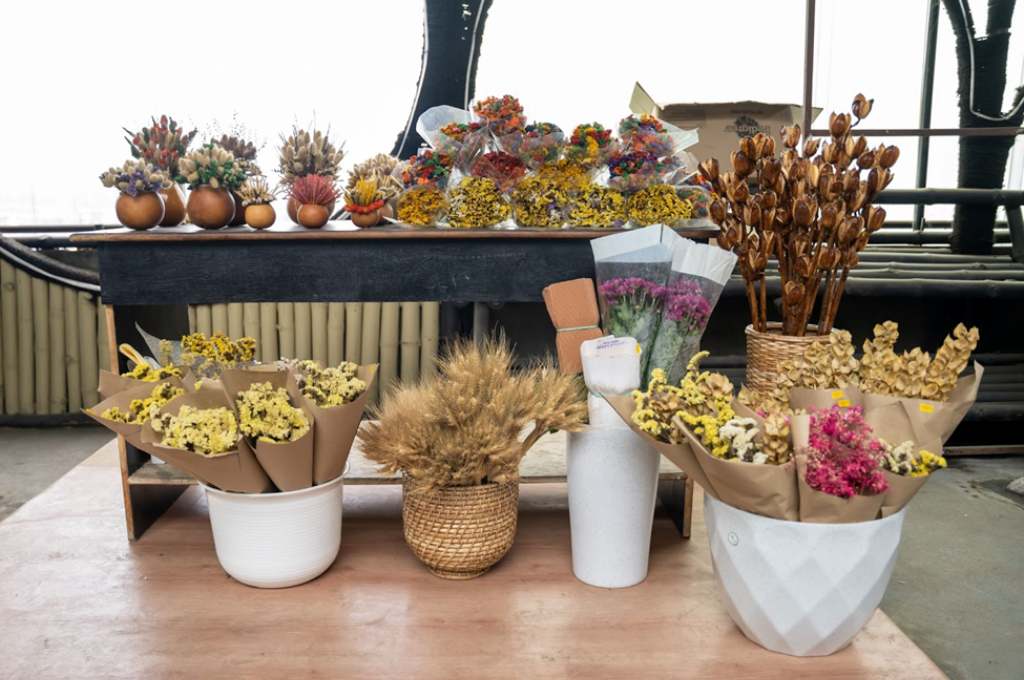
However, both Temsuyangla and Meyievino emphasise the need for mass production to meet demand, which the society struggles with due to a lack of funds and support. “We Nagas have land, abundant water, and fertile soil in many regions—all of which is suitable for growing flowers. If we can connect these resources, we can become a stronger society.” She suggests that a greater number of women residing in various districts can be mobilised, trained, and equipped with materials to cultivate fresh seasonal flowers. This approach aims to supply Kohima and Dimapur with local flowers, thereby decreasing the need to fulfil flower orders from outside the state, as well as generating employment opportunities. She adds, “By bridging the gap and building a strong network, we could also confidently supply flowers daily to customers from other states.”
The Nagaland Flower Growers Society remains hopeful that organisations will step in to help them organise groups of entrepreneurs across all districts and provide the tools necessary to start growing, preserving, and supplying flowers for a thriving floriculture industry.
—
Know more
- Watch this documentary to learn more about the dry flower business in Nagaland.
- Learn about the life of a career trainer in Nagaland to understand the changing youth aspirations in the state.






